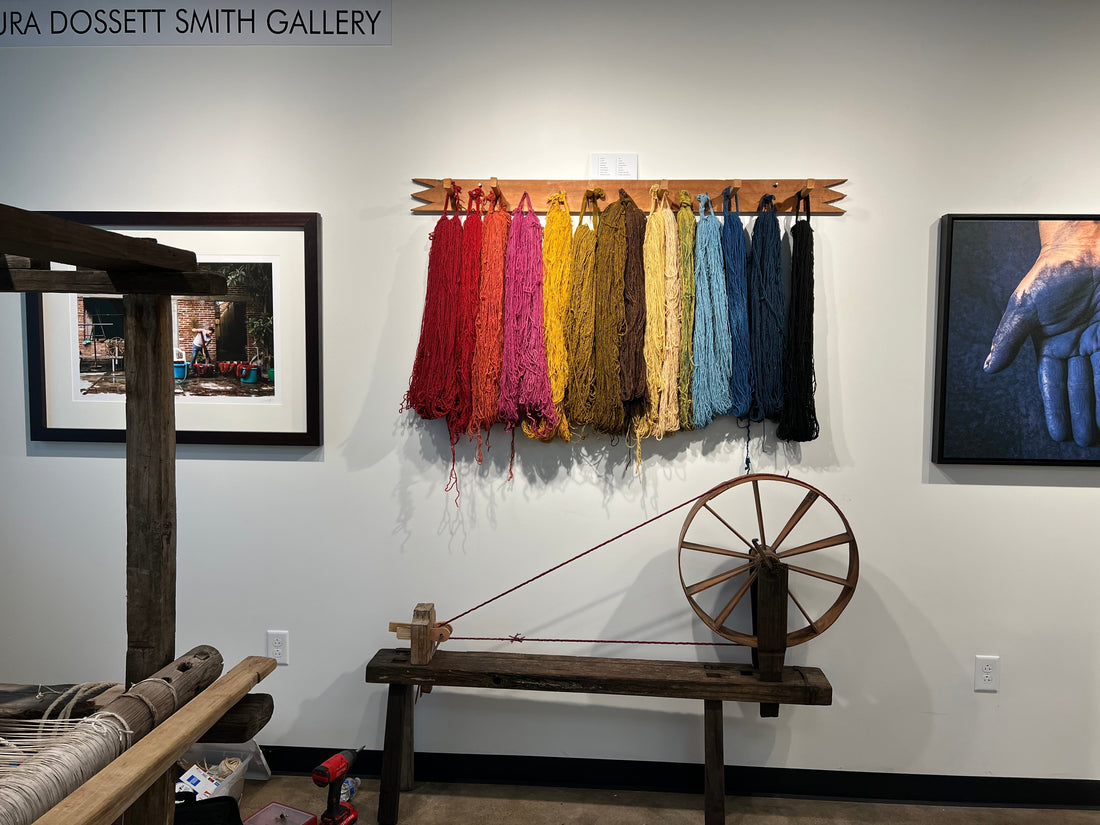
The Art of Natural Dyeing – Colors of the Earth, Woven by Hand
In Oaxaca, color isn’t just seen — it’s felt.
Each hue tells a story of patience, land, and ancestral memory.
At Huaje Art, we honor this slow ritual of transformation — where plants, roots, and insects become pigment, and pigment becomes soul.

🌿 What Is Natural Dye?
Natural dye is color made from organic materials — plants, roots, minerals, bark, and insects.
Unlike synthetic dyes, natural dyes carry the fingerprint of place and season. Each batch varies slightly, creating the unique warmth and depth seen in handmade textiles.
At Huaje Art, we primarily use wool, which holds color beautifully and creates vibrant, long-lasting tones.
For special collaborations and wearable pieces, we also use cotton — especially in projects with Oaxaca-based textile artist María Ospina MX.
🌿 From Family Roots to Living Color
The journey of Huaje Art begins with Verónica and Alejandro, artisans from Teotitlán del Valle, Oaxaca — a village where weaving is identity.
In 2012, their partnership merged two worlds: Alejandro, living between Orange County and Oaxaca, and Verónica, continuing her family’s legacy of weaving and dyeing.
While the 1990s brought synthetic dyes that were faster and cheaper, something vital was lost — the organic dialogue between color and craft.
Together, they chose the slower path: returning to ancestral knowledge of plant and mineral dyeing to create textiles with authenticity, patience, and cultural depth.

🪶 From the Earth to the Thread
Inside the studio, clay pots simmer quietly, and wool yarns swirl in fragrant dye baths.
Each color takes hours — sometimes days — to reveal itself.
Natural dyeing is a conversation, not a formula.
The result: every Huaje Art textile is one-of-a-kind, reflecting the mood of the season and the artisan’s touch.
❤️ Cochineal – The Color of Life (and History)
Cochineal, a small insect that lives on nopal cactus, produces a brilliant crimson when crushed.
Huaje Art sources cochineal from mountain communities across Oaxaca, supporting local families who preserve this ancient skill.
By combining it with lime, ash, or salt, we reveal shades from deep burgundy to soft rose — hues that move with light and life.
🕊 A Color That Traveled the World
During the Spanish colonial period, cochineal became one of the most valuable exports from New Spain — traded across Europe and Asia.
Artists and textile makers used Oaxaca’s red to dye silks, woolens, and sacred robes. For centuries, Indigenous growers, Spanish merchants, and European artisans were linked through this color.
✨ Today, Huaje Art keeps that legacy alive — transforming cochineal into art meant to be lived with and loved.
Sources:
- Bleichmar, D. (2009). Visible Empire: Botanical Expeditions and Visual Culture in the Hispanic Enlightenment. University of Chicago Press.
- Smithsonian Museum of Natural History, Cochineal: A Bright Red History (https://naturalhistory.si.edu/exhibits/cochineal).

🌼 Marigold (Pericón) – The Sun’s Golden Thread
Known in Oaxaca as pericón, marigold brings sunlight into fiber.
Fresh petals simmer slowly in aluminum pots, releasing golden tones of amber, honey, and warmth.
When the wool emerges, it glows — radiating the energy of the sun itself.

Source:
- Cardon, D. (2007). Natural Dyes: Sources, Tradition, Technology and Science. Archetype Publications.
🍎 Pomegranate – The Shade of Memory
From the husks of pomegranate fruit comes a dye as earthy as the desert.
Fermented and boiled, it reveals bronze, taupe, and walnut tones — quiet, grounding shades that complement the bolder reds and blues.
These natural neutrals echo adobe walls, clay, and the timeless calm of Oaxaca’s valleys.
💙 Indigo (Niltepec) – The Breath of the Sky
Añil, or indigo, is one of humanity’s oldest dyes.
Our indigo comes from Niltepec, Oaxaca, where families continue cultivating and fermenting the añil plant through age-old methods.
In our studio, the process feels magical: wool turns from green to blue before your eyes — a transformation powered by air itself.
Indigo’s depth evokes the calm of twilight, carrying serenity into every thread.

Sources:
- Cardon, D. (2007). Natural Dyes: Sources, Tradition, Technology and Science.
- UNESCO Intangible Cultural Heritage: Traditional Knowledge of Indigo in Oaxaca, Mexico (https://ich.unesco.org/).
🌸 Collaboration: Textile Artist María Ospina MX
We’re honored to collaborate with María Ospina MX, a textile artist and clothing designer based in Oaxaca.
Verónica leads the natural dyeing of cotton and linen fabrics for María’s garment collections, creating wearable color rooted in tradition.
Their partnership bridges weaving, fashion, and storytelling — celebrating Oaxacan craftsmanship in both home and wearable art.
Information about María Ospina MX sourced from interviews and features published by Qué Pasa Oaxaca (https://www.quepasaoaxaca.com/).
✨ Rooted in Tradition, Dyed for the Future
At Huaje Art, color isn’t chosen from a chart — it’s born from the land.
Every rug, runner, and textile we create is woven with Oaxacan wool and, in select projects, hand-dyed cotton, each carrying nature’s rhythm.
When you welcome a Huaje Art piece into your home, you bring with it centuries of color wisdom — living proof that art and earth can still move in harmony.
🛍 Explore the Natural Dye Collection → https://huajeart.com/collections/natural-dye
